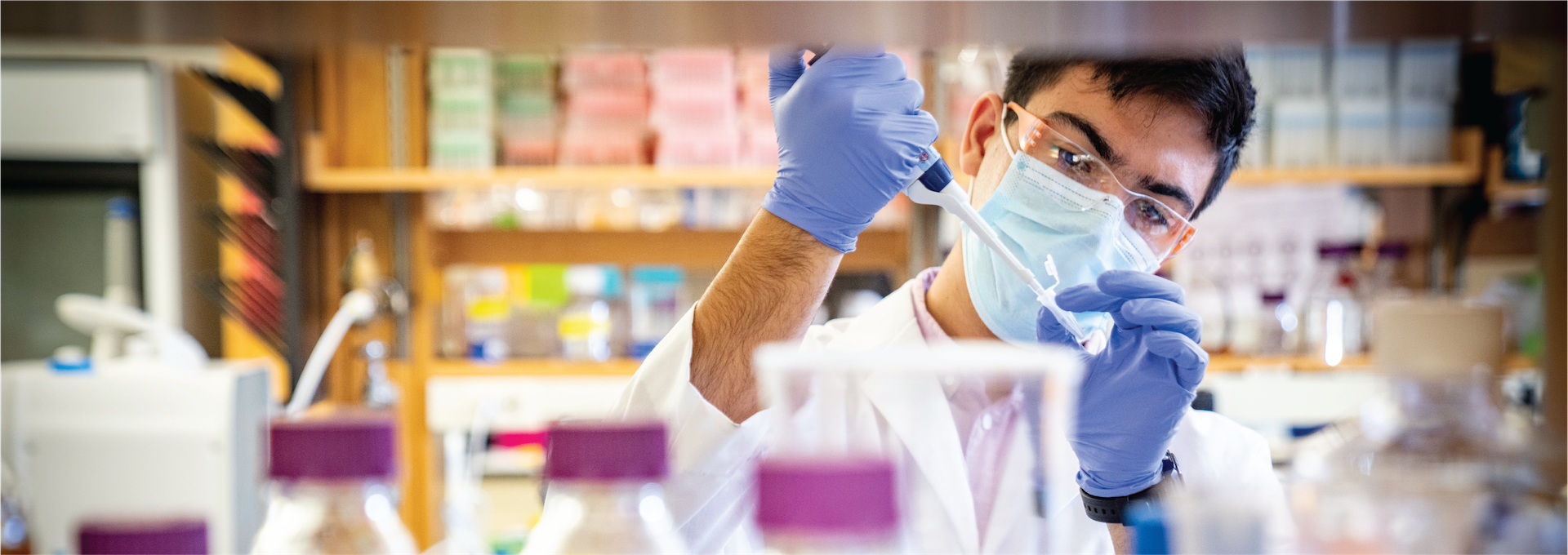Degree Requirements
Requirements for the Ph.D. in Biological Sciences
- Coursework Requirements: because the breadth of interests within the Program in Biological Sciences is diverse, our program is highly flexible. Students must complete 24 credits of didactic courses, with the specific courses taken being determined by the student in consultation with their advisor and the Director of Graduate Studies.
- Professional Development: students participate in a series of professional development activities, including the yearly construction and discussion of an individual development plan.
- Qualifying Examination: the qualifying exam is taken in the third year of graduate training after the completion of didactic courses. The qualifying exam is comprised of written and oral components and is designed to assess the student’s knowledge as well as evaluate the student’s ability to formulate hypotheses and design experiments to test those hypotheses. The qualifying exam also provides constructive feedback on the student’s thesis project.
- Annual Committee Meetings: following successful passage of qualification, students participate in annual or biannual meetings with their thesis committee. These meetings are designed to enhance each student’s growth in research and the profession.
- Dissertation: a Ph.D. in biological sciences is completed after the successful written and oral defense of a thesis that details the student’s research accomplishments and how these novel findings advance their field of research.
- Timeline: the Ph.D. in biological sciences is designed to be completed within five to six years.
Ph.D. Courses
The molecular and cellular basis of immunity. Emphasis on molecular structure, the genetic origin of diversity in B-cell and T-cell receptors, antigen presentation, and the cellular interactions leading to the immune response. Tolerance, tumor and transplantation immunity, autoimmune and immunodeficiency diseases, and allergy.
Study of innate mechanisms for measurement of time in living organisms. Emphasis on the functional significance and physiological basis of biological clocks in animals and humans. Topics include circadian rhythms, time-compensated celestial navigation, photoperiodism, and the role of biological clocks in human behavior.
Ecological, evolutionary, social, and economic aspects of biodiversity loss and ecosystem disruption due to human activities. Climate change, habitat fragmentation, species overexploitation, and invasive species. Sustainable development, habitat restoration, and species reintroduction.
Microorganisms, including bacteria, archaea, eukaryotes, viruses, and their mobile genetic elements. Origins, universality, and diversity of microbial life. Modes of genome evolution, symbioses between microbes and hosts, biotechnology, applications, and human microbiome.
Biology and epidemiology of eukaryotic parasites of medical and veterinary significance. Diagnosis, treatment, and control of parasitic protists, platyhelminthes, nematodes, and arthropods. Impact on global health.
Population biology, evolutionary ecology, community structure, with emphasis on species interactions, including competition, predation, and symbiosis. No credit for students who have earned credit for 2238.
Theoretical and empirical research on the evolution of behavior. Evolutionary approaches to the study of animal behavior, including the role of behavior in foraging, competition, predator-prey interactions, and sociality. Behavioral adaptations and their roles in sexual selection, mating systems, and animal communication.
Application of genetics, cell biology, and molecular biology to the study of human diseases. Genomics, gene mapping, and molecular techniques. Animal models of disease. Chromosomal abnormalities, single-gene and multifactorial diseases, and epigenetics.
Application of cell biology, molecular biology, and genetics to the study of cancer. Tumorigenesis; cellular oncogenes; growth factor signaling; tumor suppressor genes; apoptosis; metastasis and invasion.
The theory of evolution at the molecular level. The evolution of DNA and RNA sequences, proteins, and genome structures will be studied using models from population genetics and comparative approaches. Molecular clocks, the evolution of gene regulation and globin genes, molecular phylogeny, and human evolution.
Structure and function of nerve cells. Emphasis on electrical excitability, synaptic transmission, and sensory transduction. Cellular mechanisms underlying simple behaviors, sensory information processing, and learning and memory.
Nerve cell interactions in neuronal networks of the central nervous system of animals and their impact for regulating behavior. Sensory systems, sensory-motor integration, central processing of information, neuronal-hormonal interactions; and brain anatomy and organization in invertebrates and vertebrates.
Molecules of neural wiring, involving cell identity, pathfinding, synaptogenesis. Molecules of nerve cell communication, with relationship to drugs of addiction and abuse. Molecules of nervous system plasticity, and the mechanistic bases of learning and memory. Relation of these mechanisms to causes of human neurological diseases.
Biochemistry of the expression, transmission, and maintenance of genetic information. DNA transcription, replication, recombination, and repair. Structural mechanisms and biological functions of DNA processing proteins. Offered on a graded basis only.
Principles of classical and molecular genetic analysis: mutation and recombination, mapping, and the application of genetic methodology to the study of complex systems. Special emphasis on modern genomic approaches.
Application of genetics, biochemistry, molecular and cell biology to the study of viruses. Virus structure and classification, viral strategies of gene expression, genome replication, particle assembly. Host defenses against viruses. Comparisons with other infectious agents. Discussion of real-world outbreaks.
An introduction to statistical methods used in the analysis of biological experiments, including the application of computer software packages. Emphasis on testing of hypotheses and experimental design. Topics include descriptive statistics, analysis of variance, regression, correlation, contingency analysis, and the testing of methods for sampling natural populations.
Aims and importance of the science. Retrieval of genome data from public databases; experimental and computational methods used in analysis of genome data and their annotation. Functional aspects of genomics, transcriptomics, and proteomics; use of phylogenetics and population genomics to infer evolutionary relationships and mechanisms of genome evolution.
In-depth analysis of three to four research areas in molecular and cell biology taught by experts in each subdiscipline through lectures and discussions of papers from the current literature.
Brain and Behavior provides a basic understanding of the human central nervous system and human behavior. The format includes lectures, lab exercises, small-group discussions, and patient case presentations. Brain and Behavior integrates three areas of medical science: (1) neuroanatomy, physiology, and biochemistry; (2) psychopathology and systems neuroscience; and (3) pathology, pharmacology, and radiology.
Graduate students in biological sciences may take graduate courses in School of Medicine departments by arrangement.
